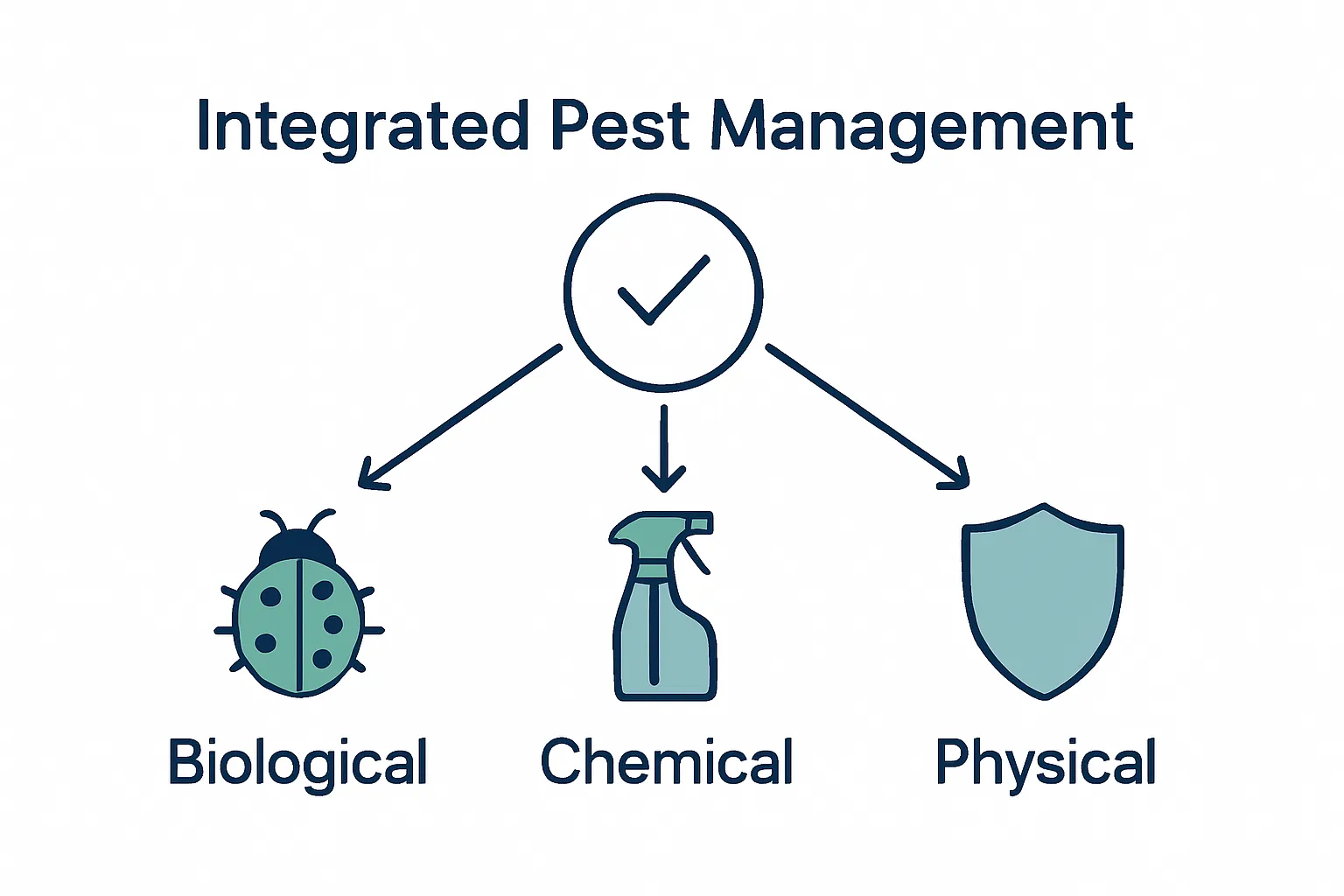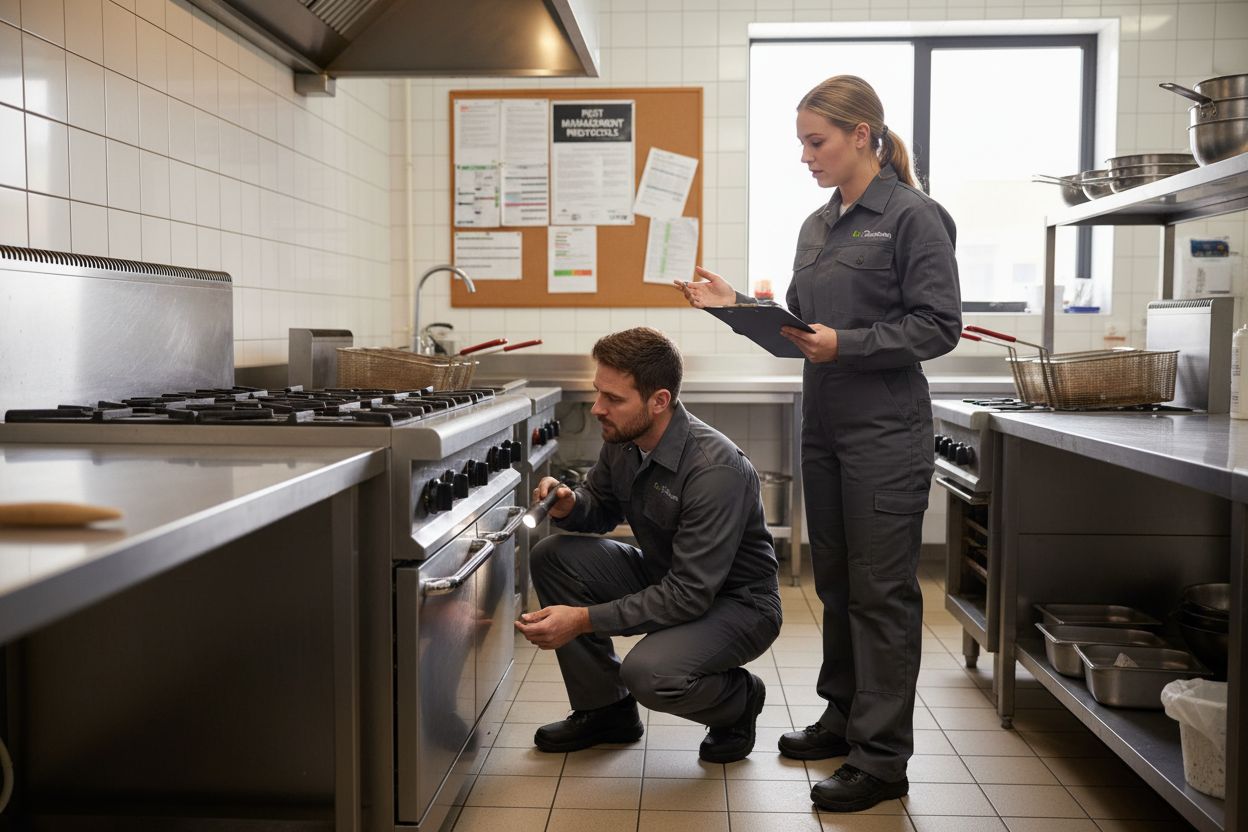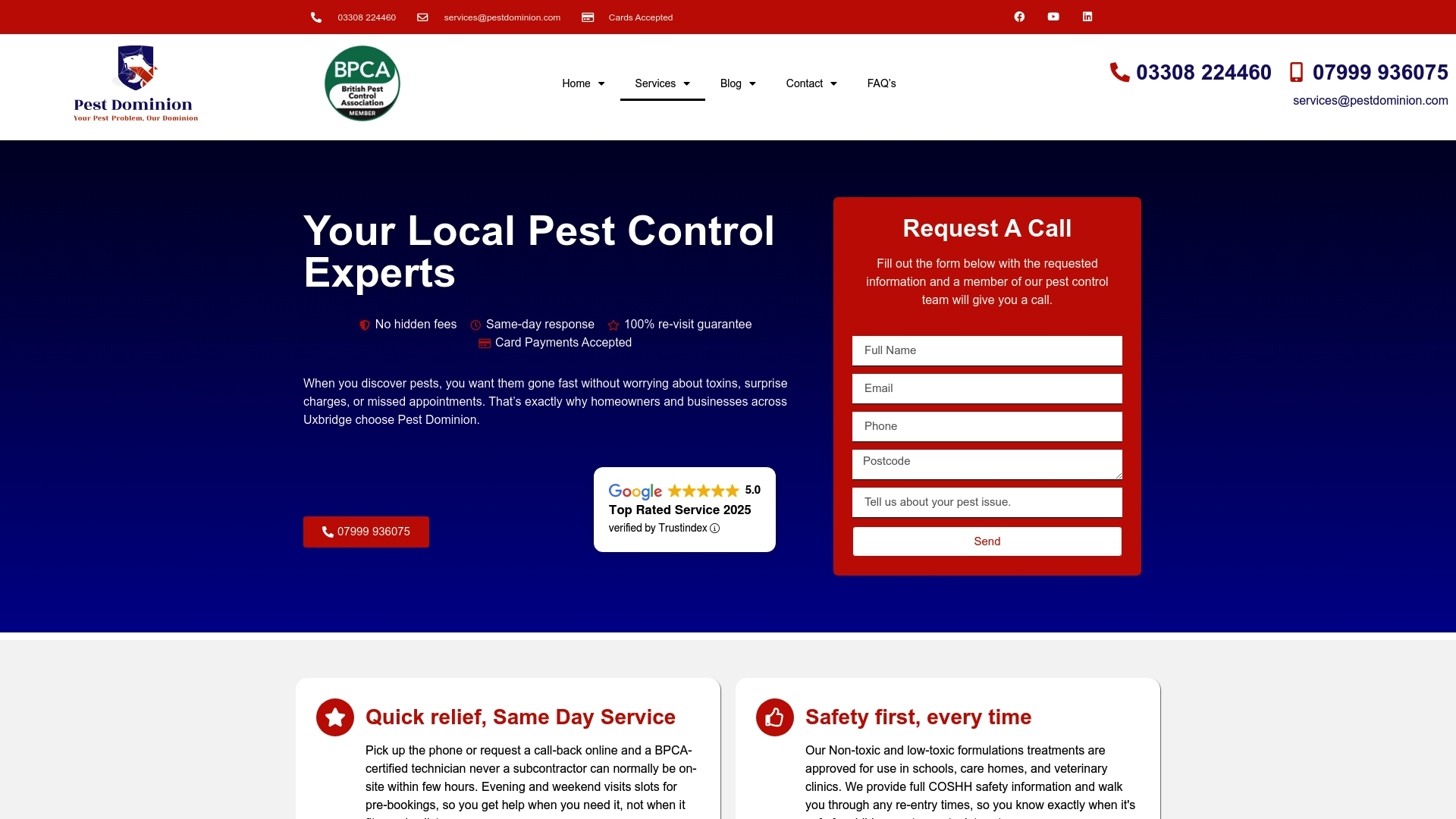Pest control might sound dull at first, just someone coming round to sort a few bugs or mice. Yet pests are behind some of the world’s biggest headaches, with termites alone causing billions in property damage every year. Oddly, the real challenge of pest control is not just fighting pests you can see but tackling the invisible threats that spread disease and harm health before you even know they are there.
Table of Contents
- Defining Pest Control: What Is It?
- The Importance of Pest Control: Why It Matters
- How Pest Control Works: Key Concepts and Methods
- Types of Pests Targeted by Pest Control
- The Role of Professionals in Pest Management
Quick Summary
| Takeaway | Explanation |
|---|---|
| Effective pest control protects health. | Pest control prevents disease transmission from pests like rodents and mosquitoes, which can carry serious pathogens. |
| Integrated Pest Management is crucial. | This approach combines various strategies for long-term pest prevention while considering environmental impacts and safety. |
| Professional assessments enhance control. | Experts identify specific pest types and assess risks, allowing for tailored treatment plans that address unique infestation challenges. |
| Pests can cause economic damage. | Pest infestations lead to significant financial losses, such as structural damage from termites and contamination from rodents. |
| Preventive measures are essential. | Professionals focus on mitigating root causes of infestations through inspections and modifications, ensuring long-term protection against pests. |
Defining Pest Control: What Is It?
Pest control represents a systematic approach to managing, preventing, and eliminating unwanted organisms that pose risks to human health, property, and environmental safety. At its core, pest control involves identifying, monitoring, and implementing targeted strategies to control populations of insects, rodents, birds, and other organisms that can cause damage or spread disease.
The Fundamental Concept of Pest Management
Pest control is more than simply removing visible pests. It is a comprehensive discipline that requires understanding the biology, behaviour, and ecological interactions of different pest species. According to World Health Organization, effective pest management involves a multi-faceted approach that considers environmental factors, potential health risks, and sustainable control methods.
Key objectives of professional pest control include:
- Protecting human health from disease transmission
- Preventing structural damage to buildings and infrastructure
- Minimising economic losses in agricultural and commercial settings
- Maintaining ecological balance by controlling invasive species populations
Methods and Professional Approaches
Professional pest control services employ various techniques tailored to specific pest types and environments. These methods range from biological controls and chemical treatments to advanced integrated pest management strategies. Pest Dominion’s pest control solutions demonstrate how targeted interventions can effectively address different pest challenges while prioritising safety and environmental responsibility.
Understanding pest control requires recognising that each infestation is unique. Experts conduct thorough inspections, identify specific pest species, assess potential risks, and develop customised treatment plans that address both immediate concerns and long-term prevention strategies. This scientific and strategic approach distinguishes professional pest management from temporary, one-size-fits-all solutions.
The Importance of Pest Control: Why It Matters
Pest control transcends mere nuisance management and represents a critical protective strategy for public health, property preservation, and economic stability. The significance of professional pest management extends far beyond surface-level interventions, addressing complex systemic challenges that impact communities, businesses, and individuals.
Public Health Protection
Pests are not just unwelcome visitors but potential vectors of serious diseases. According to Public Health England, numerous pest species can transmit dangerous pathogens that pose significant health risks. Rodents, for instance, can spread leptospirosis, salmonellosis, and hantavirus, while insects like mosquitoes are known carriers of malaria, dengue fever, and West Nile virus.
Key health risks associated with uncontrolled pest populations include:
- Transmission of infectious diseases
- Allergic reactions and respiratory complications
- Food contamination and potential poisoning
- Psychological stress and mental health impacts
Economic and Property Preservation
Beyond health concerns, pest infestations can cause substantial economic damage. Our pest control solutions highlight how professional intervention prevents potentially catastrophic financial losses. Termites alone cause billions in structural damage annually, while rodents can compromise electrical systems, contaminate food supplies, and destroy agricultural crops.
Commercial and residential properties face significant risks from unmanaged pest populations. Professional pest control serves as a critical preventative measure, protecting infrastructure, maintaining hygiene standards, and preserving property value through targeted, scientifically informed interventions.
How Pest Control Works: Key Concepts and Methods
Pest control operates through a sophisticated, scientific methodology that combines diagnostic assessment, strategic intervention, and ongoing monitoring. This comprehensive approach ensures effective management of pest populations while minimising environmental impact and potential health risks.
Integrated Pest Management (IPM)
Integrated Pest Management represents the gold standard in contemporary pest control strategies. According to Environmental Protection Agency, IPM is a holistic framework that focuses on long-term pest prevention through a combination of biological, cultural, physical, and chemical management techniques.
Key principles of IPM include:
Integrated Pest Management (IPM) is central to modern pest control approaches. The table below summarises the primary components and guiding principles that define the IPM methodology.
| IPM Principle | Purpose |
|---|---|
| Comprehensive pest identification and assessment | Ensures accurate targeting of control measures |
| Understanding pest life cycles and interactions | Optimises intervention timing and method selection |
| Least-toxic control methods prioritised | Minimises health and ecological risks |
| Continuous monitoring and adaptive strategies | Enables ongoing effectiveness and rapid response |
| Environmental and human health risk reduction | Safeguards people and supports ecosystem balance |

- Comprehensive pest identification and assessment
- Understanding pest life cycles and environmental interactions
- Implementing least-toxic control methods first
- Continuous monitoring and adaptive strategies
- Minimising risks to human health and ecosystem balance
Professional Assessment and Treatment Techniques
Professional pest control begins with a meticulous inspection process. Experts conduct thorough site evaluations to identify specific pest species, assess infestation levels, and determine potential entry points. Our comprehensive pest control services utilise advanced diagnostic tools and techniques to develop targeted treatment plans.
Treatment methods vary depending on the pest type and environmental context. Professionals may employ biological controls like introducing natural predators, physical barriers, chemical treatments, or a combination of strategies. The goal is always to achieve maximum pest suppression with minimal ecological disruption, ensuring safe and sustainable pest management.
Types of Pests Targeted by Pest Control
Pest control addresses a wide spectrum of organisms that pose potential risks to human health, property, and environmental stability. These pests range from tiny insects to larger mammals, each presenting unique challenges and requiring specialised management strategies. Understanding the diversity of pest species is crucial for implementing effective control measures.
To clarify the wide array of pests targeted by professional pest control, the following table categorises the main types and highlights the associated risks or challenges each presents.
| Pest Category | Examples | Key Risks and Challenges |
|---|---|---|
| Flying Insects | Wasps, flies, mosquitoes | Disease transmission, stings, nuisance |
| Crawling Insects | Ants, cockroaches, bed bugs | Infestation, food contamination, health issues |
| Wood-destroying Insects | Termites, wood beetles | Structural property damage |
| Fabric/Food-contaminating Insects | Moths, weevils | Spoilage of foodstuffs, damage to textiles |
| Rodents | Rats, mice | Disease spread, gnawing damage, contamination |
| Other Mammals | Squirrels, foxes | Physical property damage, environmental disruption |
Insect Pest Categories
Insects represent the most numerous and diverse group of pests encountered in residential and commercial environments. According to NHS Health Resources, certain insects can transmit serious diseases and cause significant health complications.
Key insect pest categories include:
- Flying insects (wasps, flies, mosquitoes)
- Crawling insects (ants, cockroaches, bed bugs)
- Wood-destroying insects (termites, wood beetles)
- Fabric and food-contaminating insects (moths, weevils)
Rodent and Mammalian Pest Management
Our comprehensive pest control services specifically target mammalian pests that can cause substantial property damage and health risks. Rodents like rats and mice are particularly problematic, capable of spreading diseases, contaminating food supplies, and causing structural damage through persistent gnawing.
Beyond rodents, pest control also addresses other mammalian intruders such as squirrels, which can compromise electrical systems, and larger animals like foxes that may disrupt urban and suburban environments. Professional pest control employs humane and scientifically informed techniques to manage these populations effectively, balancing ecological considerations with human safety requirements.
The Role of Professionals in Pest Management
Professional pest management represents a sophisticated scientific discipline that goes far beyond simple extermination. Trained experts bring specialised knowledge, advanced technologies, and comprehensive strategies to address complex pest-related challenges, ensuring safe, effective, and sustainable solutions for residential and commercial environments.
Expert Knowledge and Diagnostic Skills
Professional pest control technicians undergo extensive training to develop intricate understanding of pest behaviour, biology, and ecological interactions. According to British Pest Control Association, these specialists possess critical skills that enable precise identification, assessment, and targeted intervention strategies.
Key professional competencies include:
- Advanced species identification techniques
- Understanding complex pest life cycles
- Comprehensive risk assessment capabilities
- Knowledge of environmental impact considerations
- Technical expertise in treatment methodologies
Strategic Intervention and Prevention
Our pest exclusion solutions demonstrate how professionals approach pest management as a holistic process. Rather than simply eliminating existing pests, experts focus on comprehensive prevention strategies that address root causes of infestations. This approach involves detailed site inspections, identifying potential entry points, recommending structural modifications, and implementing long-term protective measures.
Professional pest management distinguishes itself through scientific precision, combining biological understanding, advanced technological tools, and strategic planning to deliver comprehensive pest control solutions that protect human health, property integrity, and environmental balance.

Ready to Break Free from Pest Problems in Slough and Beyond?
After learning about the vital role of pest control in protecting your health, property, and peace of mind, you may be thinking about the risks that hidden infestations and ineffective DIY treatments can cause. The article highlights how unchecked pests can lead to illness, costly damage, and recurring stress. With Pest Dominion Limited, you never have to face these threats alone. Our local experts know the most effective methods to safeguard your home or business in line with the integrated pest management approaches detailed in the article.

Take action now with a trusted team that combines quick response, clear communication, and proven results. Discover how our professional inspections and tailored solutions can deliver a healthier, pest-free environment. Start protecting what matters today with Pest Dominion Limited. Explore our full range of expert pest control services for your property and book your inspection through our official website. Your safety and comfort are just one call away.
Frequently Asked Questions
What is pest control and why is it important?
Pest control is a systematic approach to managing and eliminating unwanted organisms that pose risks to health, property, and the environment. It is important for protecting human health from disease, preventing property damage, and ensuring economic stability.
What methods are used in pest control?
Various methods are employed in pest control, including biological controls, chemical treatments, and integrated pest management (IPM) strategies. These approaches are tailored to specific pest types and environments to ensure effective management while prioritising safety and environmental responsibility.
How does integrated pest management (IPM) work?
Integrated Pest Management (IPM) is a holistic framework that focuses on long-term pest prevention. It combines biological, cultural, physical, and chemical management techniques while emphasising comprehensive pest identification, monitoring, and the minimisation of risks to human health and ecosystems.
What types of pests are commonly targeted by pest control services?
Pest control services typically target a wide range of pests, including insects such as ants, cockroaches, and termites, as well as rodents like rats and mice. Each pest requires specialised management strategies to effectively reduce their populations and mitigate associated risks.

